5.1-day01-C++語言語法基礎
阿新 • • 發佈:2018-11-29
bank.cpp
 先進行編譯,然後再取別名執行檔案;
g++ bank.cpp
g++ -o bank bank.cpp
./bank
先進行編譯,然後再取別名執行檔案;
g++ bank.cpp
g++ -o bank bank.cpp
./bank
 std:: 名字空間:
作用域限定運算子,相當於:“的”字元。
std:: 名字空間:
作用域限定運算子,相當於:“的”字元。
bool.cpp
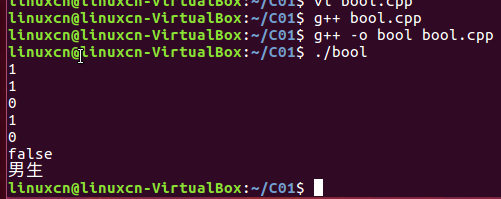 -----------------------------------------------------
-----------------------------------------------------
 因為,char *p = null, b = p; 此時,boolalpha = false;
boolalpha以字元顯示方式進行格式控制;
因為,char *p = null, b = p; 此時,boolalpha = false;
boolalpha以字元顯示方式進行格式控制;
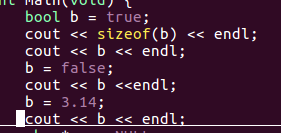
因為b是bool型別的,b = 3.14 , cout << b << endl; 後的值為1. -------------------------------------------------- sex = 3 是bool型別的,猜測sex是True,男生”;
--------------------------------
驗證:
sex = 3 是bool型別的,猜測sex是True,男生”;
--------------------------------
驗證:

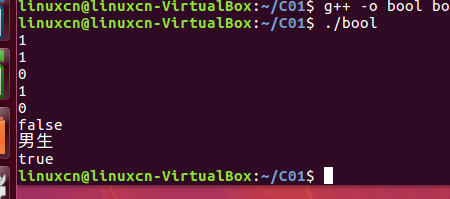 ----------------------------
sizeof(空結構)-> 1
----------------------------
sizeof(空結構)-> 1
cfunc.c
defarg.cpp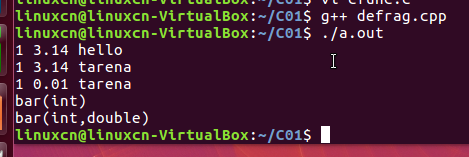 -----------------------
-----------------------

 過載:在同一作用域中,函式名相同,引數表不同的函式,構成過載關係
過載:在同一作用域中,函式名相同,引數表不同的函式,構成過載關係
int foo (int a, double b) {} int foo (int b, double a) 函式名相同,引數名相同的不構成過載關係; 關注的是引數表的型別,不關心其名字;
過載解析: (1)最優匹配原則; (2)最小工作量原則;
函式名標識的是函式的地址,C++中函式名 可以重複,但是地址不一樣。 const char * c= "tarena" 表示預設值;預設值一律靠右; 預設引數放在宣告語句當中 ,宣告是給編譯器看的;
 過載:需要用同一個函式(函式名是死的)來實現兩個不同的功能;
v1 : void decode (int arg) {...}
v2: void decode (void) {}
---------------------------------------------
過載:需要用同一個函式(函式名是死的)來實現兩個不同的功能;
v1 : void decode (int arg) {...}
v2: void decode (void) {}
---------------------------------------------
兩個不同 函式用同一個名; 只有型別而沒有名字的形參,渭之“啞元”。 佔著位置而不起任何作用; -------------------------------------------------- gcc -std=c++ 0x 使用2011標準去編譯;
g++ 1.cpp -std=c++ 0x -------------------------------------------- (1)如果呼叫一個函式時,沒有提供實參,那麼對應的形參就取預設值; (2)如果一個引數帶有預設值,那麼它後面的所有引數都必須都帶有預設值; (3)如果一個函式宣告和定義分開,那麼預設引數只能放在宣告中; (4)避免和過載發生歧義; (5)只有型別而沒有名字的形參,謂之啞元;
enum.cpp 在這種 情況下,程式可以順利進行編譯;
在這種 情況下,程式可以順利進行編譯;
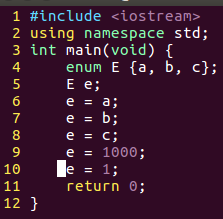
 在這種情況下,編譯出錯。
列舉是 一種獨立的資料型別,和整型之間不能進行隱式轉換。
在這種情況下,編譯出錯。
列舉是 一種獨立的資料型別,和整型之間不能進行隱式轉換。
hello.cpp
 輸出: cout - 標準輸出物件;(控制檯輸出物件)
輸入: cin - 標準輸入物件;
插入運算子: << (把字串的字面值插入到cout內)
提取運算子: >>
輸出: cout - 標準輸出物件;(控制檯輸出物件)
輸入: cin - 標準輸入物件;
插入運算子: << (把字串的字面值插入到cout內)
提取運算子: >>
std::cout (控制檯輸出物件) << "Hello,world !" <<(多次插入) std::endl;(換行\n)
math.cpp
nsover.cpp
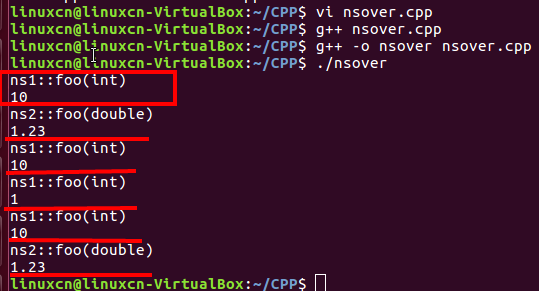
overload.cpp
struct.c
C語言中的空結構大小為0;
struct.cpp
 C++中類和結構沒有區別;
sizeof (空結構) -> 1;
C++中類和結構沒有區別;
sizeof (空結構) -> 1;
union.cpp


 gcc -std=c++0x 使用2011編譯器去編譯;-2011標準;
gcc -std=c++0x 使用2011編譯器去編譯;-2011標準;
來自為知筆記(Wiz)
#include <iostream>using namespace std;//namespace {void print (int money) {cout << money << endl;}//}// 農行名字空間namespace abc {int balance = 0;void save (int money) {balance += money;}void draw (int money) {balance -= money;}}namespace abc {void salary (int money) {balance += money;}void print (int money) {cout << "農行:";::print (money);}}// 建行名字空間namespace ccb {int balance = 0;void save (int money) {balance+= money;}void draw (int money) {balance -= money;}void salary (int money) {balance += money;}}int main (void) {using namespace abc; // 名字空間指令save (5000);cout << "農行:" << balance << endl;draw (3000);cout <<"農行:" << balance << endl;ccb::save (8000);cout << "建行:" << ccb::balance << endl;ccb::draw (5000);cout << "建行:" << ccb::balance << endl;using ccb::salary; // 名字空間宣告// using abc::salary;salary (6000);cout << "建行:" << ccb::balance << endl;abc::print (abc::balance);return 0;}
 先進行編譯,然後再取別名執行檔案;
g++ bank.cpp
g++ -o bank bank.cpp
./bank
先進行編譯,然後再取別名執行檔案;
g++ bank.cpp
g++ -o bank bank.cpp
./bank
 std:: 名字空間:
作用域限定運算子,相當於:“的”字元。
std:: 名字空間:
作用域限定運算子,相當於:“的”字元。
bool.cpp
#include <iostream>using namespace std;void print (bool sex) {if (sex)cout << "男生" << endl;elsecout << "女生" << endl;}int main (void) {bool b = true;cout << sizeof (b) << endl;cout << b << endl;b = false;cout << b << endl;b = 3.14;cout << b << endl;char* p = NULL;b = p;cout << b << endl;cout << boolalpha << b << endl;bool sex;sex = 3;print (sex);return 0;}

 -----------------------------------------------------
-----------------------------------------------------
 因為,char *p = null, b = p; 此時,boolalpha = false;
boolalpha以字元顯示方式進行格式控制;
因為,char *p = null, b = p; 此時,boolalpha = false;
boolalpha以字元顯示方式進行格式控制;

因為b是bool型別的,b = 3.14 , cout << b << endl; 後的值為1. --------------------------------------------------
 sex = 3 是bool型別的,猜測sex是True,男生”;
--------------------------------
驗證:
sex = 3 是bool型別的,猜測sex是True,男生”;
--------------------------------
驗證:

 ----------------------------
sizeof(空結構)-> 1
----------------------------
sizeof(空結構)-> 1
cfunc.c
void foo (int a) {}
defarg.cpp
#include <iostream>using namespace std;void foo (int a = 10, double b = 0.01,const char* c = "tarena");void foo (void) {}void bar (int) {cout << "bar(int)" << endl;}void bar (int, double) {cout << "bar(int,double)" << endl;}int main (void) {foo (1, 3.14, "hello");foo (1, 3.14);foo (1);// foo (); // 歧義bar (100);bar (100, 12.34);return 0;}void foo (int a /* = 10 */, double b /* = 0.01 */,const char* c /* = "tarena" */) {cout << a << ' ' << b << ' ' << c << endl;}
 -----------------------
-----------------------

 過載:在同一作用域中,函式名相同,引數表不同的函式,構成過載關係
過載:在同一作用域中,函式名相同,引數表不同的函式,構成過載關係
int foo (int a, double b) {} int foo (int b, double a) 函式名相同,引數名相同的不構成過載關係; 關注的是引數表的型別,不關心其名字;
過載解析: (1)最優匹配原則; (2)最小工作量原則;
函式名標識的是函式的地址,C++中函式名 可以重複,但是地址不一樣。 const char * c= "tarena" 表示預設值;預設值一律靠右; 預設引數放在宣告語句當中 ,宣告是給編譯器看的;
 過載:需要用同一個函式(函式名是死的)來實現兩個不同的功能;
v1 : void decode (int arg) {...}
v2: void decode (void) {}
---------------------------------------------
過載:需要用同一個函式(函式名是死的)來實現兩個不同的功能;
v1 : void decode (int arg) {...}
v2: void decode (void) {}
---------------------------------------------
兩個不同 函式用同一個名; 只有型別而沒有名字的形參,渭之“啞元”。 佔著位置而不起任何作用; -------------------------------------------------- gcc -std=c++ 0x 使用2011標準去編譯;
g++ 1.cpp -std=c++ 0x -------------------------------------------- (1)如果呼叫一個函式時,沒有提供實參,那麼對應的形參就取預設值; (2)如果一個引數帶有預設值,那麼它後面的所有引數都必須都帶有預設值; (3)如果一個函式宣告和定義分開,那麼預設引數只能放在宣告中; (4)避免和過載發生歧義; (5)只有型別而沒有名字的形參,謂之啞元;
enum.cpp
#include <iostream>using namespace std;int main (void) {enum E {a, b, c};E e;e = a;e = b;e = c;// e = 1000;// e = 1;return 0;}
 在這種 情況下,程式可以順利進行編譯;
在這種 情況下,程式可以順利進行編譯;

 在這種情況下,編譯出錯。
列舉是 一種獨立的資料型別,和整型之間不能進行隱式轉換。
在這種情況下,編譯出錯。
列舉是 一種獨立的資料型別,和整型之間不能進行隱式轉換。
hello.cpp
#include <iostream>int main (void) {std::cout << "Hello, World !" << std::endl;int i;double d;char s[256];// scanf ("%d%lf%s", &i, &d, s);std::cin >> i >> d >> s;// printf ("%d %lf %s\n", i, d, s);std::cout << i << ' ' << d << ' ' << s << '\n';return 0;}

 輸出: cout - 標準輸出物件;(控制檯輸出物件)
輸入: cin - 標準輸入物件;
插入運算子: << (把字串的字面值插入到cout內)
提取運算子: >>
輸出: cout - 標準輸出物件;(控制檯輸出物件)
輸入: cin - 標準輸入物件;
插入運算子: << (把字串的字面值插入到cout內)
提取運算子: >>
std::cout (控制檯輸出物件) << "Hello,world !" <<(多次插入) std::endl;(換行\n)
math.cpp
calc.c3
extern "C" {int add (int a, int b) {return a + b;}int sub (int a, int b) {return a - b;}}/*extern "C" int add (int a, int b, int c) {return a + b + c;}*/
#include <stdio.h>int add (int, int);int main (void) {printf ("%d\n", add (10, 20));return 0;}
nsover.cpp
using ns1::foo; ns1中的foo被引入到作用域中了;
#include <iostream>using namespace std;namespace ns1 {int foo (int a) {cout << "ns1::foo(int)" << endl;return a;}};namespace ns2 {double foo (double a) {cout << "ns2::foo(double)" << endl;return a;}};int main (void) {using namespace ns1;using namespace ns2;cout << foo (10) << endl;cout << foo (1.23) << endl;using ns1::foo;cout << foo (10) << endl;cout << foo (1.23) << endl;using ns2::foo;cout << foo (10) << endl;cout << foo (1.23) << endl;return 0;}

overload.cpp
#include <iostream>using namespace std;void foo (int a) {cout << "foo(int)" << endl;}void bar (int a) {}//int foo (int a) {}int foo (int a, double b) {cout << "foo(int,double)" << endl;}int foo (double a, int b) {cout << "foo(double,int)" << endl;}//int foo (int b, double a) {}int main (void) {foo (100);foo (100, 1.23);foo (1.23, 100);// foo (100, 100);return 0;}

struct.c
#include <stdio.h>int main (void) {struct A {};printf ("%d\n", sizeof (struct A));struct A a;struct A* pa = &a;printf ("%p\n", pa);return 0;}

C語言中的空結構大小為0;
struct.cpp
#include <iostream>using namespace std;struct Student {char name[128];int age;void who (void) {cout << "我叫" << name << ",今年" << age<< "歲了。" << endl;}};int main (void) {Student student = {"張飛", 25}, *ps = &student;student.who ();ps->who ();struct A {};cout << sizeof (A) << endl;return 0;}
 C++中類和結構沒有區別;
sizeof (空結構) -> 1;
C++中類和結構沒有區別;
sizeof (空結構) -> 1;
union.cpp
#include <iostream>using namespace std;int main (void) {// 匿名聯合union {int x;char c[4] /*= {'A', 'B', 'C', 'D'}*/;};cout << (void*)&x << ' ' << (void*)c << endl;x = 0x12345678;for (int i = 0; i < 4; ++i)cout << hex << (int)c[i] << ' ';cout << endl;return 0;}


 gcc -std=c++0x 使用2011編譯器去編譯;-2011標準;
gcc -std=c++0x 使用2011編譯器去編譯;-2011標準;
來自為知筆記(Wiz)
